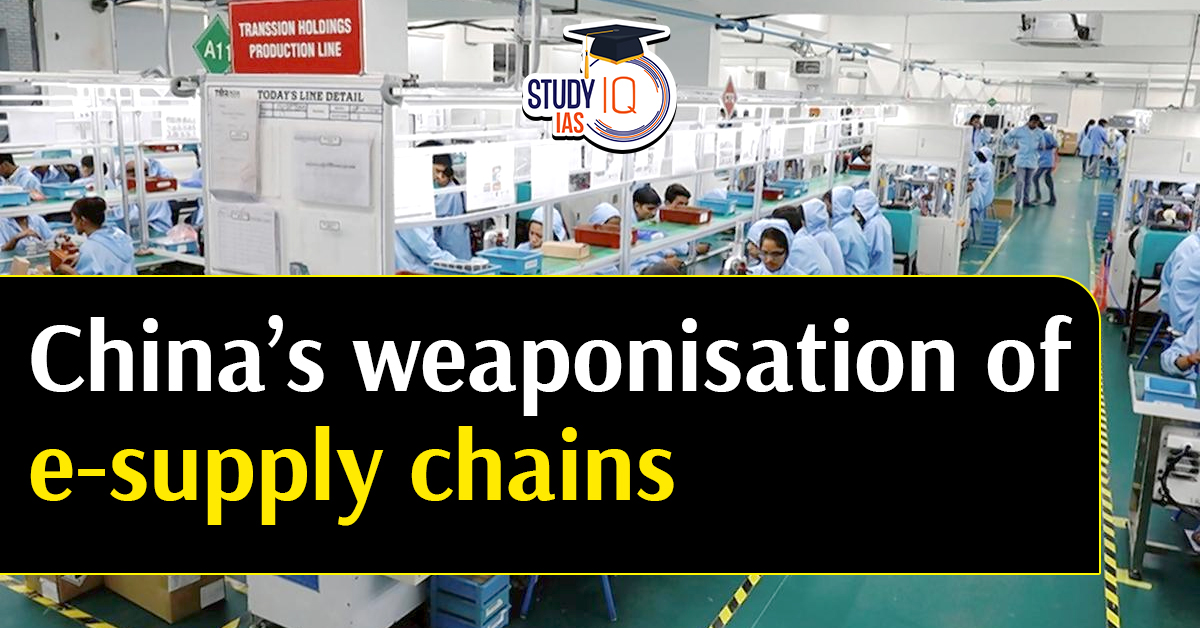Table of Contents
Context: China has restricted the travel of its engineers and technicians working in Foxconn’s facilities in India.
More in News
- Chinese authorities are also recalling those already in India.
- Additionally, China has imposed curbs on the export of critical, specialized manufacturing equipment over which it has a monopoly.
- These measures aim to disrupt India’s manufacturing sector, particularly its electronics industry, by limiting knowledge transfer and halting the supply of crucial machinery.
Case Study: Apple-Foxconn in India
- Expansion in India: Apple and its contract manufacturers (Foxconn, Pegatron, Tata Electronics) have significantly expanded their presence in India.
- Foxconn’s facility in Tamil Nadu and Tata Electronics’ plant in Karnataka are assembling iPhone models.
- Production Milestones: In FY 2023-24, Apple assembled iPhones worth $14 billion in India.
- For the first time, iPhone 16 Pro models were assembled by Foxconn in India in 2024.
- Government Support: State governments in South India have prioritized Apple-Foxconn investments.
- The Indian government conferred the Padma Bhushan on Young Liu, Chairman of Foxconn, in 2024, highlighting the company’s strategic importance.
- Challenges:
- India remains largely a final assembly hub rather than a full-fledged manufacturing ecosystem.
- China’s restrictions on skilled labor and critical equipment supply pose serious challenges.
India’s Steps to Boost Electronics Manufacturing
- Production-Linked Incentive (PLI) Scheme: First launched in 2020 for the electronics industry.
- Increased budget allocation from ₹6,125 crore ($0.70 billion) in 2024 to ₹8,885 crore ($1.02 billion) in 2025.
- Apple’s contract manufacturers in India received ₹6,600 crore ($0.76 billion) over the past three years.
- Custom Duty Reduction: Union Budget 2025 removed basic custom duties on mobile phone components like:
- Printed circuit boards
- Camera modules
- Connectors and sensors
- Machinery for lithium-ion battery manufacturing
- National Manufacturing Mission: Announced in the Union Budget to support small, medium, and large industries.
- Aims to develop industrial clusters and promote technological knowledge-sharing.
- Skill Development Initiatives: On-site training programs to ensure tacit knowledge transfer in electronics manufacturing.
- Plans to integrate industry-specific specialization in skill development programs.
How India Can Counter China’s Actions
- Engaging Apple & Foxconn for Negotiations: Since both companies have stakes in India and China, they can negotiate with Beijing to ease restrictions.
- Strengthening Domestic Supply Chains: Incentivizing local manufacturers to produce specialized machinery and components.
- Developing a robust domestic contract manufacturing network.
- Expanding Technological Self-Reliance: Encouraging private capital to invest in R&D for electronic components.
- Promoting semiconductor and chip manufacturing under the India Semiconductor Mission.
- Diversification of Supply Chains: Strengthening trade partnerships with alternative supplier nations like Taiwan, Japan, South Korea, and the U.S.
- Reducing Dependence on China:Encouraging Indian firms to enter high-end electronics manufacturing.
- Promoting joint ventures with non-Chinese foreign players.
- Enhancing Infrastructure & Policy Support: Speeding up the creation of electronics manufacturing clusters.
- Providing tax incentives and subsidies to attract high-tech investments.


 India-Middle East-Europe Economic Corrid...
India-Middle East-Europe Economic Corrid...
 US-Iran Nuclear Talks: Key Developments ...
US-Iran Nuclear Talks: Key Developments ...
 EU Plans to Slash General Data Protectio...
EU Plans to Slash General Data Protectio...





















